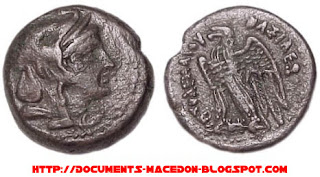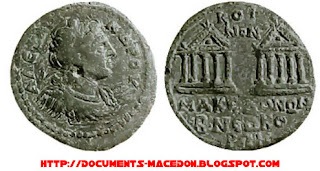
Lysimachos lifetime silver tetradrachm from Amphipolis, Macedonia, c. 288-281 BC, 16.7g, Sear 6815, SNG Cop. 1114, SNG Hart 351, Thompson 193, Mørkholm 178, Müller 106. Alexander wears a Horn of Ammon (ram's horn, symbolic of the Greco-Egyptian composite god Zeus-Ammon) and diadem (headband of cloth and ivy leaves worn as a sign of royalty). Alexander is depicted with fiery eyes, as if he's about to enter battle, the eyes staring out of a deep shadow cast by the heavy brow. The intended overall effect is an image of a bold and aggressive leader animated with divine inspiration. This and similar renditions of Alexander on Lysimachos' coinage are widely regarded as among the most gripping portraits of Alexander on coinage. Ancient fourree counterfeit Lysimachos tetradrachm, 14.1g.
Ancient fourree counterfeit Lysimachos tetradrachm, 14.1g. Lysimachos Mithradates the Great-portrait tetradrachm, Byzantion, Thrace, c. 75-70 BC, 15.2g, Sear 1589, SNG Cop. 1142, Müller 175. Mithradates is depicted as Alexander.
Lysimachos Mithradates the Great-portrait tetradrachm, Byzantion, Thrace, c. 75-70 BC, 15.2g, Sear 1589, SNG Cop. 1142, Müller 175. Mithradates is depicted as Alexander. Lysimachos Alexander-portrait gold stater from Kallatis, Thrace, c. 44-42 BC, 8.3g, Sear 1661, SNG Cop. 1089v. (different mint mark under Nike). Debate exists over whether this variety depicts Alexander or Mithradates.
Lysimachos Alexander-portrait gold stater from Kallatis, Thrace, c. 44-42 BC, 8.3g, Sear 1661, SNG Cop. 1089v. (different mint mark under Nike). Debate exists over whether this variety depicts Alexander or Mithradates. Ptolemy I Alexander-portrait silver tetradrachm from Alexandria, Egypt, c. 310-305 BC, 15.7g, Sear 7750v., SNG Cop. 30, Svoronos 169, Anthony 207. The coin depicts a refined, deified rendering of Alexander.
Ptolemy I Alexander-portrait silver tetradrachm from Alexandria, Egypt, c. 310-305 BC, 15.7g, Sear 7750v., SNG Cop. 30, Svoronos 169, Anthony 207. The coin depicts a refined, deified rendering of Alexander. Ptolemy II Alexander-portrait bronze (AE-23) from Alexandria, Egypt, c. 285-246 BC, Sear 7780v., Svoronos 424, SNG Cop. 158v. (delta instead of A). This coin depicts one of three Alexander styles on Ptolemy bronzes, with Alexander in an elephant skin headdress and a Horn of Ammon.
Ptolemy II Alexander-portrait bronze (AE-23) from Alexandria, Egypt, c. 285-246 BC, Sear 7780v., Svoronos 424, SNG Cop. 158v. (delta instead of A). This coin depicts one of three Alexander styles on Ptolemy bronzes, with Alexander in an elephant skin headdress and a Horn of Ammon. Ptolemy I Alexander-portrait bronze (AE-19) from Alexandria, Egypt, c. 310-305 BC, Sear 7766v., Svoronos 155, SNG Cop. 38. Alexander has long hair and wears a Horn of Ammon and diadem but no elephant skin headdress, an image sometimes identified as Apollo.
Ptolemy I Alexander-portrait bronze (AE-19) from Alexandria, Egypt, c. 310-305 BC, Sear 7766v., Svoronos 155, SNG Cop. 38. Alexander has long hair and wears a Horn of Ammon and diadem but no elephant skin headdress, an image sometimes identified as Apollo. Ptolemy V Alexander-portrait bronze (AE-21) from Alexandria, Egypt, c. 204-180 BC, Sear 7883, Svoronos 1236, SNG Cop. 250, Weiser 143. Alexander wears an elephant skin headdress but no horn of Ammon. Because of the somewhat effeminate portrait rendition, it's sometimes suggested that it could represent the king's wife, Cleopatra I.
Ptolemy V Alexander-portrait bronze (AE-21) from Alexandria, Egypt, c. 204-180 BC, Sear 7883, Svoronos 1236, SNG Cop. 250, Weiser 143. Alexander wears an elephant skin headdress but no horn of Ammon. Because of the somewhat effeminate portrait rendition, it's sometimes suggested that it could represent the king's wife, Cleopatra I. Seleukos I silver tetradrachm from Susa, Persia, c. 305-295 BC, 16.7g, Sear 6833v., Houghton-Lorber 173(5), Kritt A27-A32, Mørkholm 139, Franke-Hirmer 740, Newell ESM 424. Alexander wears a panther skin helmet and a bull's horn and ears, with the ears acting as cheek pieces. A panther pelt encircles his neck, with its paws tied under his chin. Some scholars interpret this figure as Alexander, some as Seleukos I, some as the god Dionysos, and some as a combination of two or more of the above. It's most likely Alexander as Dionysos.
Seleukos I silver tetradrachm from Susa, Persia, c. 305-295 BC, 16.7g, Sear 6833v., Houghton-Lorber 173(5), Kritt A27-A32, Mørkholm 139, Franke-Hirmer 740, Newell ESM 424. Alexander wears a panther skin helmet and a bull's horn and ears, with the ears acting as cheek pieces. A panther pelt encircles his neck, with its paws tied under his chin. Some scholars interpret this figure as Alexander, some as Seleukos I, some as the god Dionysos, and some as a combination of two or more of the above. It's most likely Alexander as Dionysos. Ancient fourree counterfeit Seleukos I tetradrachm, 14.1g.
Ancient fourree counterfeit Seleukos I tetradrachm, 14.1g. Seleukos I bronze (AE-13) from Sardes, Lydia, c. 281-280 BC, Sear 6852, SNG Cop. 36, SNG Spaer 23-24, Lindgren I 1751. Alexander has a winged head. Sometimes this image is described as Alexander, sometimes as a winged Medusa, sometimes as Medusa with the features of Alexander. It's mostly likely Alexander as Medusa. Issued after the Battle of Corupedion pitting the forces of Seleukos against those of Lysimachos, both in their 70s. Lysimachos was killed and Seleukos won, taking over Asia Minor.
Seleukos I bronze (AE-13) from Sardes, Lydia, c. 281-280 BC, Sear 6852, SNG Cop. 36, SNG Spaer 23-24, Lindgren I 1751. Alexander has a winged head. Sometimes this image is described as Alexander, sometimes as a winged Medusa, sometimes as Medusa with the features of Alexander. It's mostly likely Alexander as Medusa. Issued after the Battle of Corupedion pitting the forces of Seleukos against those of Lysimachos, both in their 70s. Lysimachos was killed and Seleukos won, taking over Asia Minor. Aesillas tetradrachm from Thessaloniki, Macedonia, c. 90-75 BC, 16.5g, Sear 1463, SNG Cop. 1330, SNG Ash. 3303-3307, Dahmen 10.1. Alexander has long hair and a Horn of Ammon. The obverse legend reads "Of the Macedonians." A theta mint mark, short for Thessaloniki, appears behind Alexander's head. The reverse depicts the name Aesillas (the Roman quaestor or financial officer in Macedonia), a club (symbol of Herakles), two symbols of the authority of the quaestor (cista or money chest and sella or quaestor's chair), and Q (looks like a P) for Quaestor, all surrounded by a wreath (sometimes identified as olive, sometimes as laurel). Other varieties have a beta or no obverse mint mark instead of the theta, different obverse or reverse legends, and pellets on the reverse.
Aesillas tetradrachm from Thessaloniki, Macedonia, c. 90-75 BC, 16.5g, Sear 1463, SNG Cop. 1330, SNG Ash. 3303-3307, Dahmen 10.1. Alexander has long hair and a Horn of Ammon. The obverse legend reads "Of the Macedonians." A theta mint mark, short for Thessaloniki, appears behind Alexander's head. The reverse depicts the name Aesillas (the Roman quaestor or financial officer in Macedonia), a club (symbol of Herakles), two symbols of the authority of the quaestor (cista or money chest and sella or quaestor's chair), and Q (looks like a P) for Quaestor, all surrounded by a wreath (sometimes identified as olive, sometimes as laurel). Other varieties have a beta or no obverse mint mark instead of the theta, different obverse or reverse legends, and pellets on the reverse. Koinon of Macedonia bronze (AE-26) from Beroea, Macedonia, c. 222-235 AD, Sear Greek Imperial 4808v. (that specimen has an A beneath the reverse inscription), SNG Cop. 1360v. (with this specimen, the horse is galloping with a star underneath it), Pozzi 2128v. (star underneath). This coin depicts one of four Alexander styles on Koinon bronzes, with Alexander wearing a diadem.
Koinon of Macedonia bronze (AE-26) from Beroea, Macedonia, c. 222-235 AD, Sear Greek Imperial 4808v. (that specimen has an A beneath the reverse inscription), SNG Cop. 1360v. (with this specimen, the horse is galloping with a star underneath it), Pozzi 2128v. (star underneath). This coin depicts one of four Alexander styles on Koinon bronzes, with Alexander wearing a diadem. Koinon of Macedonia bronze (AE-25) from Beroea, Macedonia, c. 222-235 AD, SNG Cop. 1357v. (that specimen has a diademed portrait), McClean 3727. Alexander wears an Attic helmet.
Koinon of Macedonia bronze (AE-25) from Beroea, Macedonia, c. 222-235 AD, SNG Cop. 1357v. (that specimen has a diademed portrait), McClean 3727. Alexander wears an Attic helmet. Koinon of Macedonia bronze (AE-26) from Beroea, Macedonia, c. 222-235 AD, Lindgren I 1384, AMNG III/1 416. Alexander wears a lion skin headdress.
Koinon of Macedonia bronze (AE-26) from Beroea, Macedonia, c. 222-235 AD, Lindgren I 1384, AMNG III/1 416. Alexander wears a lion skin headdress. Koinon of Macedonia bronze (AE-25) from Beroea, Macedonia, c. 238-244 AD, AMNG III/2 56v. (pentastyle instead of hexastyle temples). This coin depicts a full bust of Alexander, wearing a diadem and cuirass (armor for breast and back) and carrying a shield.
Koinon of Macedonia bronze (AE-25) from Beroea, Macedonia, c. 238-244 AD, AMNG III/2 56v. (pentastyle instead of hexastyle temples). This coin depicts a full bust of Alexander, wearing a diadem and cuirass (armor for breast and back) and carrying a shield. Apollonia Mordiaion bronze (AE-31) from Apollonia Mordiaion, Pisidia, c. 211-217 AD, Sear Greek Imperial 5138, SNG Aulock 4988, Dahmen 19.1, Lingren I 1260, BMC 19 202 1. Alexander wears a lion skin headdress.
Apollonia Mordiaion bronze (AE-31) from Apollonia Mordiaion, Pisidia, c. 211-217 AD, Sear Greek Imperial 5138, SNG Aulock 4988, Dahmen 19.1, Lingren I 1260, BMC 19 202 1. Alexander wears a lion skin headdress. Apollonia and Lycia Alliance bronze (AE-32) from Apollonia Mordiaion, Pisidia, c. 211-217 AD, Sear Greek Imperial 5139, SNG Aulock 4989, Dahmen 19.2, BMC 19 204 9. Alexander wears a lion skin headdress.
Apollonia and Lycia Alliance bronze (AE-32) from Apollonia Mordiaion, Pisidia, c. 211-217 AD, Sear Greek Imperial 5139, SNG Aulock 4989, Dahmen 19.2, BMC 19 204 9. Alexander wears a lion skin headdress. 1926 Albanian one lek (7.77g, 27mm), KM 5. Alexander has long hair, reminiscent of Aesillas tetradrachms, but no Horn of Ammon.
1926 Albanian one lek (7.77g, 27mm), KM 5. Alexander has long hair, reminiscent of Aesillas tetradrachms, but no Horn of Ammon. 1992 Greek 100 drachmas (10.2g, 29mm). KM 159. Alexander wears a Horn of Ammon and diadem, reminiscent of Lysimachos coinage.
1992 Greek 100 drachmas (10.2g, 29mm). KM 159. Alexander wears a Horn of Ammon and diadem, reminiscent of Lysimachos coinage.
Sources: RG.Ancients.info
Tuesday, January 10, 2012
Numismatic, Alexander III of Macedon
Labels: Coins
Subscribe to:
Post Comments (Atom)
Enter your email address:







0 comments:
Post a Comment